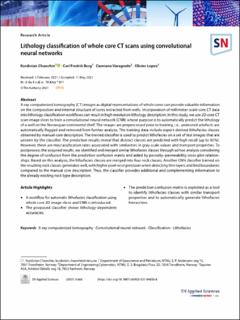| dc.contributor.author | Chawshin, Kurdistan | |
| dc.contributor.author | Berg, Carl Fredrik | |
| dc.contributor.author | Varagnolo, Damiano | |
| dc.contributor.author | Lopez, Olivier | |
| dc.date.accessioned | 2022-10-31T09:01:27Z | |
| dc.date.available | 2022-10-31T09:01:27Z | |
| dc.date.created | 2021-06-14T21:56:30Z | |
| dc.date.issued | 2021 | |
| dc.identifier.citation | SN Applied Sciences. 2021, 3 (6), 1-21. | en_US |
| dc.identifier.issn | 2523-3963 | |
| dc.identifier.uri | https://hdl.handle.net/11250/3029022 | |
| dc.description.abstract | X-ray computerized tomography (CT) images as digital representations of whole cores can provide valuable information on the composition and internal structure of cores extracted from wells. Incorporation of millimeter-scale core CT data into lithology classification workflows can result in high-resolution lithology description. In this study, we use 2D core CT scan image slices to train a convolutional neural network (CNN) whose purpose is to automatically predict the lithology of a well on the Norwegian continental shelf. The images are preprocessed prior to training, i.e., undesired artefacts are automatically flagged and removed from further analysis. The training data include expert-derived lithofacies classes obtained by manual core description. The trained classifier is used to predict lithofacies on a set of test images that are unseen by the classifier. The prediction results reveal that distinct classes are predicted with high recall (up to 92%). However, there are misclassification rates associated with similarities in gray-scale values and transport properties. To postprocess the acquired results, we identified and merged similar lithofacies classes through ad hoc analysis considering the degree of confusion from the prediction confusion matrix and aided by porosity–permeability cross-plot relationships. Based on this analysis, the lithofacies classes are merged into four rock classes. Another CNN classifier trained on the resulting rock classes generalize well, with higher pixel-wise precision when detecting thin layers and bed boundaries compared to the manual core description. Thus, the classifier provides additional and complementing information to the already existing rock type description. | en_US |
| dc.language.iso | eng | en_US |
| dc.publisher | Springer Nature | en_US |
| dc.rights | Navngivelse 4.0 Internasjonal | * |
| dc.rights.uri | http://creativecommons.org/licenses/by/4.0/deed.no | * |
| dc.title | Lithology classification of whole core CT scans using convolutional neural networks | en_US |
| dc.title.alternative | Lithology classification of whole core CT scans using convolutional neural networks | en_US |
| dc.type | Peer reviewed | en_US |
| dc.type | Journal article | en_US |
| dc.description.version | publishedVersion | en_US |
| dc.source.pagenumber | 1-21 | en_US |
| dc.source.volume | 3 | en_US |
| dc.source.journal | SN Applied Sciences | en_US |
| dc.source.issue | 6 | en_US |
| dc.identifier.doi | 10.1007/s42452-021-04656-8 | |
| dc.identifier.cristin | 1915748 | |
| dc.relation.project | Norges forskningsråd: 262644 | en_US |
| cristin.ispublished | true | |
| cristin.fulltext | original | |
| cristin.qualitycode | 1 | |

